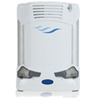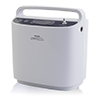Oxygen concentrators offer a convenient solution for people needing supplemental oxygen for COPD or other lung diseases. This guide will tell you how to buy an oxygen concentrator in Canada and explain which features to consider.
What is an Oxygen Concentrator?
Unlike oxygen tanks that contain oxygen, oxygen concentrators are machines that use air from the room to filter out other gases, providing you with around 90-95 percent pure oxygen.
Room air consists of roughly 21 percent oxygen, 78 percent nitrogen, and about 1 percent other trace gases. In healthy lungs, 21 percent oxygen is sufficient. But some people with COPD and lung disease require more oxygen, and that’s where oxygen concentrators come in. Oxygen concentrators draw in air from the room and filter out the nitrogen and other trace gases, delivering supplemental oxygen to you via nasal cannula or mask.
Why should I choose an oxygen concentrator over an oxygen tank?
Since oxygen concentrators “make” oxygen, you won’t run out. Whereas, oxygen tanks only have a certain amount of oxygen, running out eventually. If you use oxygen tanks, you’ll need to have them refilled routinely.
Oxygen concentrators offer a low-maintenance and portable solution for anyone needing supplemental oxygen.
Do I need a prescription to buy an oxygen concentrator in Canada?
No. You do not need a prescription to purchase an oxygen concentrator in Canada.
How much supplemental oxygen do I need?
Your doctor will provide a prescription with the amount of oxygen you require.
Although a prescription isn’t required for purchasing an oxygen concentrator, you’ll need an evaluation by your healthcare provider to ensure you’re getting the right amount of oxygen. Evaluating the need for supplemental oxygen generally includes pulse oximetry and an arterial blood gas, a blood test analyzing the saturation of gases (oxygen and carbon dioxide) in your blood.
Using the right amount of supplemental oxygen is crucial since too little or too much can be harmful to your health.
Choosing an Oxygen Concentrator
If you’re purchasing an oxygen machine without a prescription, you must ensure that it’s safe and comes from a reputable manufacturer. CAIRE, Philips Respironics, and Inogen are three leading manufacturers of oxygen supplies that offer a wide variety of features for you to consider.
Portable Oxygen Concentrators vs. Home Oxygen Concentrators
Before deciding on a machine, understand how much oxygen you’ll need and whether you require continuous flow or pulse dose oxygen delivery. Understanding your supplemental oxygen needs is crucial for choosing a suitable machine.
If you have questions about your oxygen requirements, consult your healthcare provider.
Home Oxygen Concentrators
Home oxygen concentrators (HOCs) are large, stationary units for home use only. The large size of these machines often allows for higher levels of oxygen delivery, and oxygen is provided through continuous flow, meaning the oxygen continuously runs during inspiration and expiration.
HOCs are not intended for use outside the home, and you cannot travel with them.
Portable Oxygen Concentrators
Portable oxygen concentrators (POCs) offer in-home and out-of-the-home oxygen. They’re smaller and lighter than HOCs, making them ideal for physical activities and travel.
Most POCs deliver oxygen by pulse dose, so you’ll get oxygen on inspiration with each breath, utilizing the unit’s breath-detection technology. However, some POCs offer pulse dose and continuous flow oxygen.
If you’re active, plan on leaving home with supplemental oxygen, plan to travel, or want a portable machine, consider a POC.
Features to Look for When Choosing an Oxygen Concentrator
Oxygen Delivery
Although a prescription is not required to purchase an oxygen concentrator in Canada, you’ll still need a prescription for oxygen to ensure you’re getting the right amount. Too much or too little supplemental oxygen is dangerous and puts you at risk for more severe health problems. As mentioned, it’s critical to understand your oxygen needs before selecting your unit.
Clarify with your healthcare provider whether you need continuous flow or pulse dose oxygen delivery. Continuous flow oxygen is delivered in liters per minute (lpm).
Pulse dose oxygen gets delivered by settings, but the amount of oxygen provided varies with each machine. For example, the amount of oxygen on a pulse-dose setting of 3 on one device might differ from that of 3 on another device. Therefore, looking at the oxygen delivery with each setting on all concentrators you consider is critical.
Please note that a pulse dose flow setting of 3 does not equal three LPM, so always check the manual to ensure you get the right amount of oxygen.
Size and Weight
You’ll want to consider the machine’s size when looking for portability. Ask yourself these questions:
- Is the unit light enough for you to carry?
- Does the manufacturer include a carry bag or offer backpacks or a cart with wheels?
- Is the machine big and bulky or small enough to comfortably carry?
Battery Duration and Recharging Times
When choosing a POC, check the unit’s battery duration. Many manufacturers offer large or double batteries to extend the battery’s life.
Consider these features when comparing batteries:
- How long does the battery last?
- Does the company offer an extended battery?
- Can I use the concentrator while charging the battery?
- Does the machine have a car charger for travel?
- How long does the battery take to recharge?
- How much battery life is needed for my flight?
Oxygen delivery, portability, and battery duration are significant factors when choosing an oxygen concentrator, but you might also consider:
- What is the noise level?
- Does the manufacturer offer a warranty?
- What accessories does the package include?
- Which additional accessories are available to purchase?
Traveling with Oxygen by Plane in Canada
In Canada, airlines are not required to permit the use of medical oxygen, and if traveling to the U.S., you cannot bring oxygen cylinders or tanks. However, many POCs are FAA-approved for airline travel and also accepted by Transport Canada. Always check with the airline to ensure your POC will be allowed on your flight.
Before traveling with your POC, ask your doctor for the required medical forms and recommendations for a physician in the location you’re traveling. Learn more about Flying with Oxygen in Canada.
Top Canada Portable Oxygen Concentrators
If you’re looking for a POC but unsure where to begin, these top POCs are a great place to start.

CAIRE FreeStyle Comfort
Weight: 5 pounds with 8-cell battery, 6 pounds with 16-cell battery
Dimensions: 7.3″ x 3.1″ x 10″ (with 8-cell battery)
Oxygen Delivery: Pulse dose 1-5, Max output= 1,050 ml
Battery Duration:8-cell battery: Up to 8 hours; 16-cell battery: Up to 16 hours
Noise Level: 39 dB
Learn More About the CAIRE FreeStyle Comfort

Philips Respironics SimplyGo
Weight: 10 pounds with battery
Dimensions: 11.5″ x 6″ x 10″
Oxygen Delivery: Continuous and Pulse Dose (lightest continuous flow unit)
Pulse dose settings 0.5-6; Continuous flow up to 2 lpm (increments of 0.5)
Max output= 2,000 ml/min (2 lpm)
Battery Duration: Pulse dose: Up to 3 hours 24 minutes; Continuous flow: Up to 2 hours 54 minutes
Noise Level: 43 dB (setting of 2)
Learn More About the Philips Respironics SimplyGo

Philips Respironics SimplyGo Mini
Weight: 5 pounds with standard battery, 6 pounds with extended battery
Dimensions: 8.3″ x 3.6″ x 9.4″ (with standard battery)
Oxygen Delivery: Pulse dose 1-5, Max output= 1,000 ml
Battery Duration:Standard battery: Up to 6 hours; Extended battery: Up to 12 hours
Noise Level: 43 dB (setting of 2)
Learn More About the Philips Respironics SimplyGo Mini

CAIRE SeQual Eclipse
Weight: 18.4 pounds with battery
Dimensions: 12.3” x 7.1” x 19.3
Oxygen Delivery: Continuous and Pulse Dose (most powerful pulse dose unit)
Pulse dose settings 1-9; Continuous flow up to 3 lpm (increments of 0.5)
Max output= 3,000 ml/min (2 lpm)
Battery Duration: Pulse dose: Up to 5 hours 24 minutes, Continuous flow: Up to 3 hours 42 minutes
Noise Level: 40-48 dB (depending on flow delivery and setting)
Learn More About the CAIRE SeQual Eclipse

Inogen One G5
Weight: 4.8 pounds with single battery
Dimensions: 7.19″ x 3.26″ x 8.15″ (with standard battery)
Oxygen Delivery: Pulse dose 1-6, Max output= 1,260 ml
Battery Duration: Single battery: Up to 6 hours 30 minutes; Double battery: Up to 13 hours 30 minutes
Noise Level: 39 dB (setting of 2)
Learn More About the Inogen One G5

Inogen One G4
Weight: 2.8 pounds with 4-cell battery
Dimensions: 5.91″ x 2.68″ x 7.2″ (with 4-cell battery)
Oxygen Delivery: Pulse dose 1-3, Max output= 630 ml
Battery Duration: 4-cell battery: Up to 2 hours 40 minutes; 8-cell battery: Up to 5 hours
Noise Level: 40 dB (setting of 3)
Learn More About the Inogen One G4

Inogen One G3
Weight: 4.9 pounds with 8-cell battery
Dimensions: 8.75″ x 3″ x 8.25″
Oxygen Delivery: Pulse dose 1-5, Max output= 1,050 ml
Battery Duration: 8-cell battery: Up to 4 hours 30 minutes; 16-cell battery: Up to 9 hours 30 minutes
Noise Level: Less than 39 dB (setting of 2)
Learn More About the Inogen One G3
The Oxygen Concentrator Store now ships to Oxygen Concentrators in Canada, including Ontario, Alberta, British Columbia, Quebec, and Manitoba. Contact us for more information.
Oxygen Concentrators in Canada Video
Kristina Diaz, RRT, is a health writer and registered respiratory therapist with over a decade of emergency and critical care experience. She earned respiratory care and journalism degrees in Michigan, where she was born and raised. She now resides in Florida, where she works as a full-time freelance writer and part-time respiratory therapist.
Kristina began her respiratory career in 2011 in Saginaw, Michigan. She now works in Lakeland, Florida, in one of the busiest emergency departments in the nation, treating people with various lung conditions, like COPD, asthma, and sleep apnea, among others. She maintains her Advanced Cardiovascular Life Support (ACLS) certification and is a member of the trauma team at Lakeland Regional Health Medical Center. Her favorite part of being a respiratory therapist is providing relief to people struggling to breathe.
Kristina began freelance health writing in 2014, and her work is published on multiple websites, including Philips Respironics, the American Sleep Association, the Sleep Doctor, and more. She writes about lung health, sleep disorders, nutrition, and other health-related topics. Since she was a child, she’s always wanted to write, and now she gets to combine her passion for writing with the knowledge obtained from her respiratory career.








As an American, can l buy a potable oxygen concentrator in Canada. Are they cheaper in Canada?
Our Oxygen Specialists would be happy to understand your requirements and advise the way forward. Please give us a call at (877) 644-4581.
I know our lady that needs a personal oxygen machine portable would be great. She currently has a carrying device that’s quite big. Where in Canada she can get one of these caring devices to make her day today life a little easier?
Our Oxygen Specialists would be happy to understand your requirements and advise the way forward. Please give us a call at (877) 644-4581.